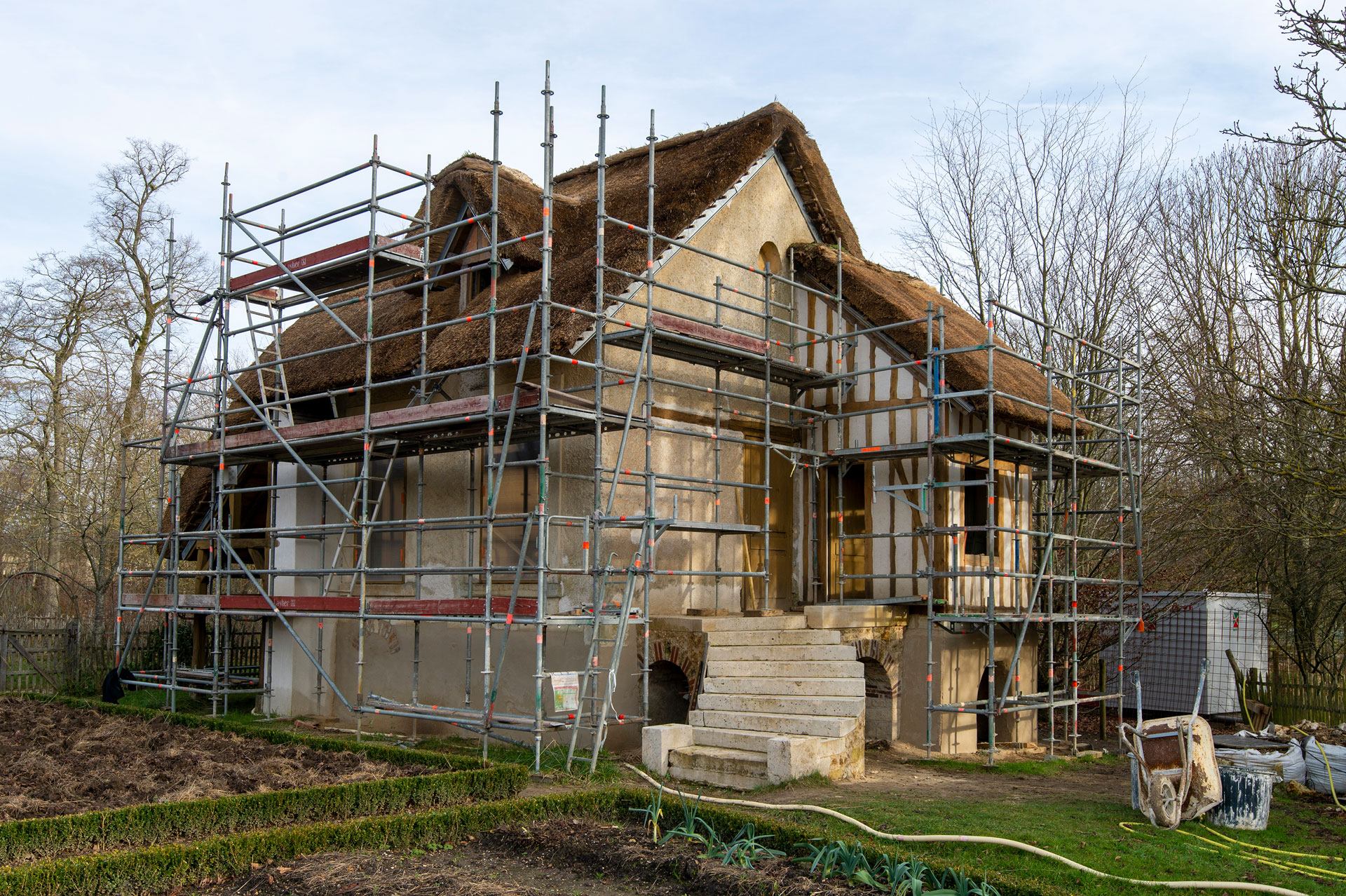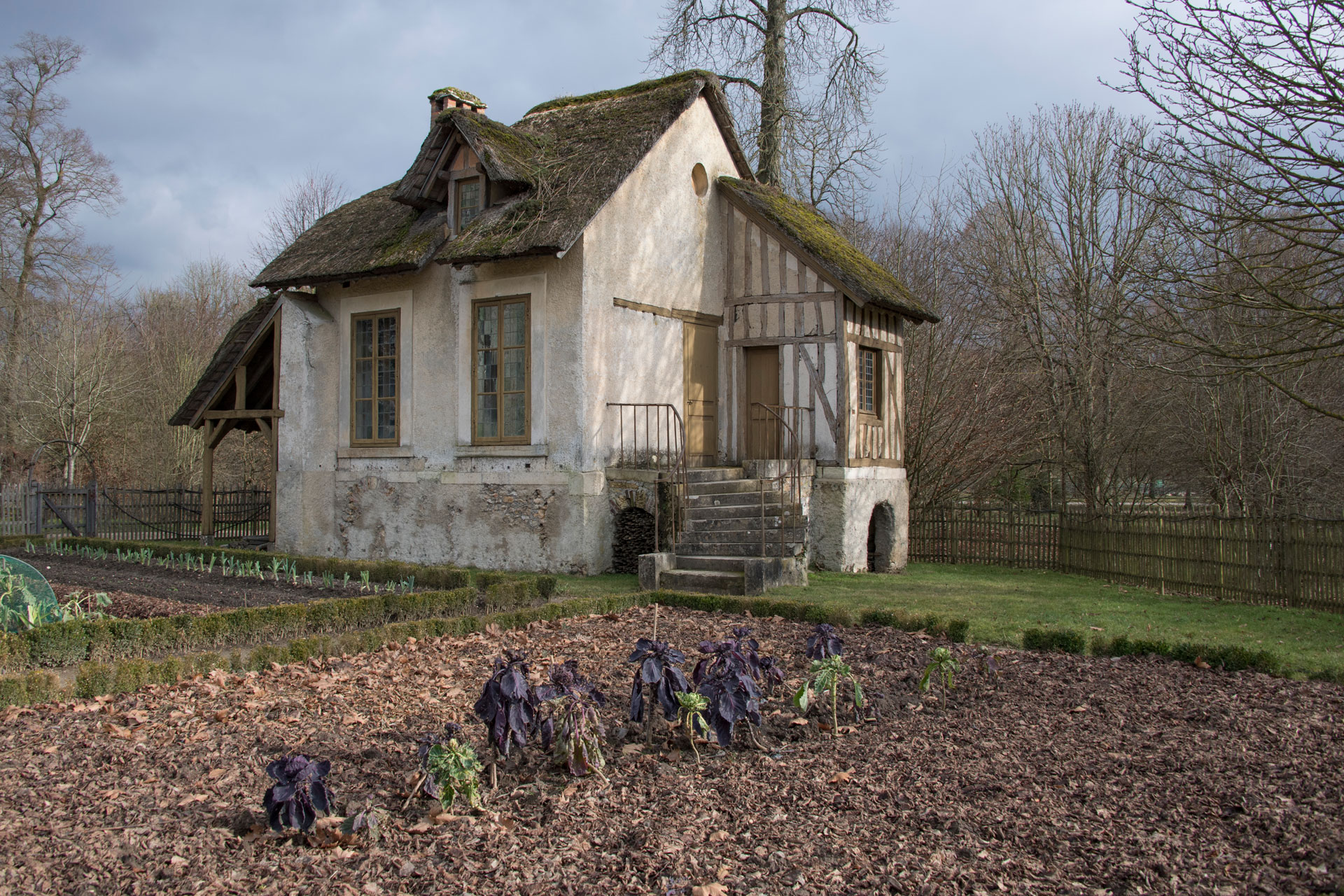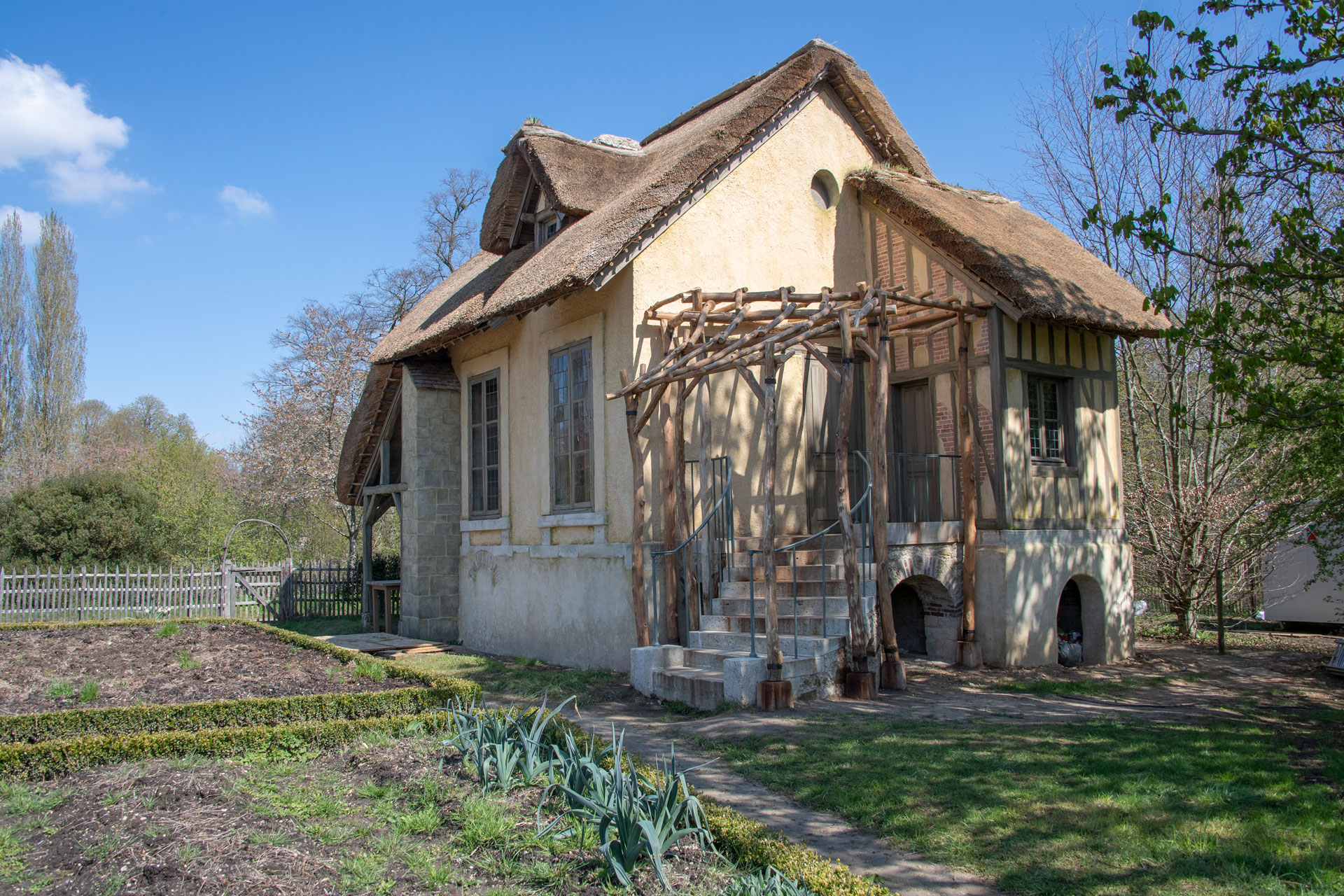The restoration of the Queen’s Boudoir, which began in January 2020, is now finished. Joiners, thatchers, decorative painters, carpenters and stonemasons all contributed to the full restoration of the building. As the work nears completion, the thatcher Philippe Le Delliou, the joiner Sébastien Antoine and the decorative painters Cathy Champion and Astrid de Chaillé look back on the work carried out during this exceptional operation.

Behind the scenes of the restoration of the Queen's Boudoir

The Queen’s Boudoir during restoration.
© EPV / Didier Saulnier
the thatcher
Interview with Philippe Le Delliou
Mr Philippe Le Delliou has been working as a thatcher in France and abroad for over 20 years, including 15 years in his own company. Previously selected for the restoration of the Farm and the Queen’s Hamlet in 2015, Mr Le Delliou talks about his latest adventure, working on the roof of the Queen’s Boudoir with three other thatchers in 2020.
Could you tell us about the work you did on the Queen's Boudoir?
As a craftsman and thatcher, I had the opportunity to rethatch the roof of the Queen’s Boudoir. Our greatest challenge during the project was drawing up a roofing plan that worked with the zinc structure installed beneath the thatch. This structure serves as a firewall and prevents the building from catching fire. We then proceeded with the roofing work. Today, we thatch with reed, which is stronger and more resistant than straw and can kept for longer: up to 40 years. To dress the roof, we use modern tools and each thatcher has its own specific technique. I personally make thatch that is 35cm thick. Although techniques have evolved and modernised, the main aim was to make it look ancient.
Had you already worked on other projects at the Palace of Versailles? If so, how was the work on the Queen's Boudoir different?
I first worked on the Queen’s Hamlet in 2015 during the restoration of the Farm. The main difference between the two projects was the appearance required, as the farm had to look even more rustic than the Queen’s Boudoir. In both cases, it was essential for the roof to appear authentic. For the Queen’s Boudoir, we paid a great deal of attention to the look of the roof. As I said, nowadays we use reed instead of straw as it was done in the 18th century, during Queen Marie Antoinette’s time. The finish is not the same. For the Queen’s Boudoir, we had to adapt the appearance, look and dressing of the reeds. For example, we decided to use reed that was not too thin because it can look too perfect. Instead, we dressed the roof with bundles of slightly twisted reeds to give it a rough effect. We also laid straw on top of the reed to give the impression that the roof was really old.
Was there a particular moment that stands out for you during the work on the Queen's Boudoir?
A few days after I arrived on site, the head architect showed me paintings of the Hamlet and its surroundings to give me a better idea of what was required. These depictions were really useful because they helped me visualise more clearly what the roof needed to look like.
What are you most proud of about this restoration project?
I have been a thatcher for 23 years and working for the Palace of Versailles is a real honour that recognises my work. I am particularly proud to have been chosen for this project.
the joiner
Interview with Sébastien Antoine
Sébastien Antoine has been working as a joiner on projects at the Palace of Versailles for over ten years. Head Joiner for the restoration of the Queen’s Boudoir, he explains the work carried out with his team.
What were the main stages of the project?
We first removed the wall panelling, windows, indoor shutters and doors of the Queen’s Boudoir. We then carried out major restoration work on the joinery, especially on the panelling which was in a particularly bad condition. We also remade certain parts. For example, we made several indoor shutters to protect the painted decoration and fabric in the Boudoir from the daylight. We made them exactly as they would have been in the past, adding mouldings that were typical of the old shutters in the Queen’s Boudoir. We also restored the wood floor, which had been previously restored in the 1980s. The restoration technique used at the time damaged part of the wood flooring which was beginning to rot. We had to remake about 30% of the floor. Lastly, we returned the different parts to their original places, exactly as they were, and made sure the “new” elements matched the restored ones. To do so, we used various wood stains and aged the wood elements to make sure they fitted in fully. In joinery, it is essential to respect the monument in question, so we always work according to the rules and practices of the time. We use the same ancient assembly techniques, such as mortise and tenon joints and dowels made of a similar wood to the original parts. Lastly, we made an openwork pergola out of chestnut posts that covers the staircase, which leads to the only entrance to the Boudoir. To avoid disrupting the work of the other professions and hindering the smooth running of the site, we made it at the very end of the project in situ according to the plans provided by the architects.
Were there any surprises during the works?
The biggest shock was the deteriorated state of the flooring after the restoration in the 1980s. When we removed the wood floor, which was necessary for the inventory and report on the condition of the site, we discovered that the battens were in a really bad state. We therefore decided to redo the floor in a more traditional way using plaster cavity infills. We also encountered a problem with the chestnut pergola. We wanted a vertical fork that could support all the other pieces, installed horizontally, but could not find one among any of our suppliers. In the end, we had to contact a forest manager directly who cut the post on site, which required a fair amount of searching. We removed the bark of the chestnut log using a plane, a tool usually used by carpenters. That was also a very enriching experience because it allowed us to rediscover forgotten know-how.
Do you have a particular memory of this project that you want to share with us?
I was particularly struck by the condition of the wood floor and by being able to restore it as traditionally as possible. I was also proud to be able to extend the life of the Boudoir and make it last. There was also an exceptional sense of complicity and coordination between the teams of the different professions. We were able to work alongside decorators, stonemasons, roofers, thatchers, gardeners and carpenters, who restored the damaged timbers when the roof was removed. Joiners and carpenters have very different working methods, so it was very interesting to be able to watch their progress and observe their techniques. It was an incredible moment when we saw the final result. We were able to admire the work of the different trades and it was impressive to see the Queen’s Boudoir given a new lease of life.
the decorative painters
Inteview with Cathy Champion and Astrid de Chaillé
The team of painters joined the site at the end of the restoration work on the Queen’s Boudoir and completed all the exterior and interior decoration of the building within five weeks. Cathy Champion and Astrid de Chaillé give us an insider’s view on this impressive challenge.
Can you tell us about the team of decorative painters and the work that was done?
There were three painters in charge of the exterior decoration and five others in charge of the interior decoration. Another team of decorative painters had prepared the materials before we arrived.
Before the work, we talked at length with the head architect’s collaborator to better understand what they were looking for in this restoration. We also visited the Queen’s House and studied images from the time, archive documents and elevations of the building. After the discussions, we proposed mahogany colour samples that instantly matched both the expectations and the historical context of the monument and were immediately validated. The interior decoration work that we carried out required traditional oil paints. These techniques and practices, which would have been used at the time, are very specific and demanding. For the exterior decoration, we mainly worked on the façades, timbers and beams of the Boudoir, to which we applied mineral paint such as silicate and pliolite paints, which allow the walls to breathe during bad weather. We also then used a patina to artificially age the paint and make it look old. This allowed us to recreate the effect of ageing on the timbers, facades and ground-level structure.
Do you have a particular memory that stands out?
The site of the Queen’s Hamlet is absolutely exceptional. From the top of the scaffolding, we had a view over the whole of the English garden and it was quite incredible. We were also to exchange with the different tradespeople on the site. For example, we worked on the wooden panels repaired by the joinery team. It was a case of real teamwork! We were also in regular contact with the conservation team at the Palace of Versailles to ensure that the colours of the painted decoration matched those of the furniture and textiles.
What are you most proud of about this project?
We are most proud of the fact that the wood sample was immediately validated after the initial presentation. We had carefully studied the requirements of the Head Architect and the Director of the Museum and this confirmed that we had succeeded in meeting their expectations.

The Queen’s Boudoir before restoration.
© EPV / Christian Milet

The Queen’s Boudoir after restoration.
© EPV / Christian Milet




